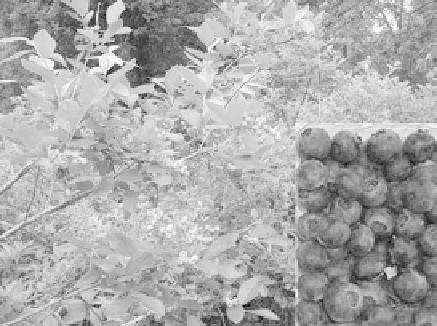Agriculture Reference
In-Depth Information
Figure
6.4.
Blueberries, inset shows ripe berries.
6.3
TREE FRUITS
6.3.1 Climatic Adaptation
Tree fruits are divided into tropical, subtropical, and temperate. Thus, as the name
implies, they are more or less restricted to these respective climatic zones. Tropical
trees are restricted to tropical areas with sufficient rainfall to support tree growth.
They are generally sensitive to both low temperatures and freezing and may be
injured or killed by either or both. Subtropical trees may be found in some tropical
and some temperate areas, although their major and best production is in the subtropical
areas. Temperate fruit trees will often grow in subtropical and tropical areas but will not
bear fruit or are not very productive. For example, apple trees will not flower unless
they experience a period of freezing!
6.3.2 Importance in Human Nutrition
Fruits from trees are a common part of the diet of people around the world. Different
climatic zones produce fruit very different in color, consistency, use, and taste. Fruit
trees are found in large orchards covering many hectares and containing hundreds of
trees or may be a single tree on a small lot. The former are commercial orchards; the
latter typically supply fruit for a single family. Plantings of small numbers of trees
are also common, and the fruits are gathered, used by the household, and then the
excess is sold in local markets. Additional nutritional information is given below.
6.3.3 Cultivation
One reason for small plantings, as opposed to single trees, primarily intended for single
household use, is that many fruit trees require a pollenizer.
§
That is, they require
§
A pollenizer is the pollen-donating plant and the pollinator is the pollen-transferring agent, for example, the
honeybee.









